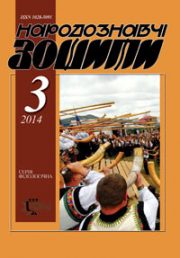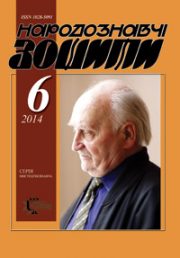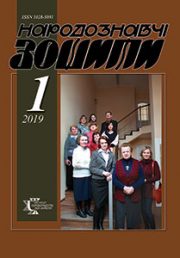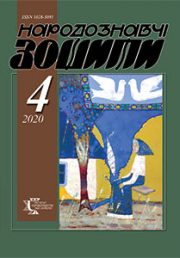The Ethnology Notebooks. 2021. № 6 (162), 1322—1334
UDK 94:[398.341:643.01](477.85)”18/19″
DOI https://doi.org/10.15407/nz2021.06.1322
BOYKO Ihor
- ORCID ID: https://orcid.org/0000-0002-3828-1835
- Doctor of Philosophy, Researcher at the Institute of Ethnology
- of the National Academy of Sciences of Ukraine,
- Department of Social Antropology,
- Svobody Avenue 15, 79000, Lviv, Ukraine
- Contacts: e-mail: I.Boyko@nas.gov.ua
LACH Janusz
- ORCID ID: http://orcid.org/0000-0001-8451-5957
- Doctor of Philosophy, lecturer, University of Wroclaw,
- Faculty of Earth Science and Environmental Management,
- Department of Regional Geography and Tourism,
- Street Z. Cybulskiego 32, room 152, 50-205 Wroclaw
- Contacts: e-mail: janusz.lach@uwr.edu.pl
Abstract. Introduction: The authors aim to find out the morphological and functional features of traditional log haylofts in the Carpathians, to develop their typology, to find out the genesis and distribution, basing on the analysis of archival sources and their own field materials. The object of study is a log hayloft; the subject: their design and functional features. The methodological basis of the article is historical-genetic and cross-cultural analysis. The study area includes the Western Carpathians within Slovakia, Poland.
As can be seen from the material, haylofts were not a specialty of the Carpathians, they occurred in many mountainous, foothill, hilly and swampy regions of Central Europe, as well as in the area of mixed forests and taiga of northern and northeastern Europe (Russia, Sweden, and Finland). In the study region, they were located mainly in the Inner Sub-Province of the Western Carpathians (most of Slovakia), locally in the Inner Sub-Province of the Eastern Carpathians (Romania). The analysis allowed the selection of different morpho-functional types of haylofts, to reveal their genesis and distribution. The main types were: a) haylofts — «kolibky» (huts), b) haylofts — «stodolky» (barns). The kolibky (huts) were built on the basis of a vatag’s hut (cheesemaker’s huts on a dairy farm), stodolky (barns) — on the basis of barns, where sheaves were stored and threshed, and on the basis of a fenced haystack (slc. «plevinets»). In the Carpathians there were also haylofts, which arose on the basis of primitive stables. Thus in the 20th century in different regions of the Carpathians there was both the transformation of the stable into a hayloft and the evolution of the hayloft into a seasonal stable; respectively, there was a transformation of meadows into glades or glades into meadows. The article highlights the features of mountain haylofts, accented markers of the Carpathian region. Carpathian features are: 1) a large percentage of haylofts of the «kolibka» (hut) type; 2) not building walls of stone, roof without rafters; 3) the spread, even in the same areas, of several types; 4) a unique Carpathian phenomenon is the use of a hayloft as a temporary housing and production complex during the temporary transformation of the hayfield into a dairy farm.
Keywords: Carpathians, log hayloft, barn, hut, phenilia, meadow farms, vatag’s hut.
Received 20.07.2021
REFERENCES
- Kubijovich, V. (1930). Types of shepherds’ life in Slovakia. Collection of the Museum of the Slovak society, 3—4, 101—109 [in Slovak].
- Holub-Pacevichova, Z. (1933—34). Shepherding in the Low Tatras. Collection of the Museum of the Slovak society, 27—28 [in Slovak].
- Podolak, J. (1961). Winter hay transportation from mountain meadows on the western side of the Great Fatra. Slovak ethnography, 10, 565—574 [in Slovak].
- Podolak, J. (2008). Traditional agriculture in Slovakia. Bratislava [in Slovak].
- Botik, J. (2014). Vysna Boca. Nizna Boca: patriotic monograph. Bratislava [in Slovak].
- Krafchikova, T. (1980). Traditional methods of meadow management in Nizhny Slavkov. New Horizons, 22, 219—229 [in Slovak].
- Marchek, A. (1976). From Krivan to Javorina. Martin [in Slovak].
- Zuskinova, I. (1999). Sheep farming and mountain milk farming in Liptov. Liptovsky Hradok [in Slovak].
- Michalek, J. et al. (1973). Liptovska Teplichka. Koshice [in Slovak].
- Medvecky, K.A. (1906). Detva. Monograph. Detva [in Slovak].
- Lazorik, J. (2002). Photo reader of folk architecture and housing in Eastern Slovakia. Preshov [in Slovak].
- Hychko J. (1971). Outbuildings in Liptov. Collection of the Slovak National Museum, 12, 71—86 [in Slovak].
- Photo archive of the Institute of Ethnology and Anthropology of the Slovak Academy of Sciences [in Slovak].
- Photo archive of the Slovak National Museum [in Slovak].
- (1995. Encyclopedia of Slovak folk culture (Vol. 2). Bratislava [in Slovak].
- Boyko, I.O. (2009). Buildings for storage of hay and straw in the Ukrainian, Polish and Slovak Carpathians (XX — the beginning of the XXI century) Fortress: collection of the reserve «Tustan»: in honor of Mykhailo Rozhko (Book 1, pp. 531—549). Lviv [in Ukrainian].
- Boyko, I. (2015). Summer cowsheds in the western and central (Ukrainian) Carpathian Moun-tains: ethnoecological parallels among the Ukrainian, Slovak, Polish, and Czech cultures. Lemkowie, Bojkowie, Rusini — history, society, material and spiritual culture (Vol. V, pp. 361—376). Slupsk; Zielona Gora; Svidnik [in Ukrainian].
- (2003). Short dictionary of the Slovak language (Collective of authors). Bratislava [in Slovak].
- Halasha, J., Marton, S. (1958). Liptovske Hole and Chocske Pohorie. Bratislava [in Slovak].
- Gierat, T. (2000). The Gorce Huts (Part I). National Parks, 2 [in Polish].
- Lach, J., Musial, M. (2015). Presence and designation of tradition for the common cultural heritage of the Beskid Mountains Small: entry in landscape. Wroclaw [in Polish].
- Lazishtan, E., Michalov, J. (1983). Wooden buildings in Slovakia. Martin [in Slovak].
- (2013). Gorali. A great book about the gorillas of Orava, Liptov and Kysuc. Martin [in Slovak].
- Langer, J. (1965). Folk architecture of the northern part of Orava. Collection of the Slovak National Museum, 59, 23—59 [in Slovak].
- Kushar, D. (2017). Compositional characteristics of wooden haylofts above Uskovnica. Arhitektura, istrazivanja, 2, 30—37 [in Slovenian].
- Sennнky (haylofts). Retrieved from: http://www.pribylinaobjektivom.sk/index.php?article=50 (Last accessed: 17.03.2018).
- Trebonske seniky (Trebon’s haylofts). Retrieved from: http://www.trebonsko.cz/trebonske-seniky (Last accessed: 03.05.2016).
- Nizny Slavkov. Retrieved from: https://www.niznyslavkov.sk/obec-1/pamiatky-obce/ (Last accessed: 11.01.2021).
- Kankaanranta, L., Leif Larsson, T. About the barns in Tornedalen and about the haymaking culture. Retrieved from: https://www.tornedalians.com/alla/minnen/lennart_kankaanranta/sv_lennart.htm (Last accessed: 21.12.2020).
- Galanin, А.V. (2009). Haymaking. Retrieved from: http://ukhtoma.ru/geobotany/applications_9.htm (Last accessed: 22.12.2020).
- Rolcik, I. Volary. Retrieved from: http://foto.mapy.cz/197054-Volary (Last accessed: 03.11.2020).
- Senнk pod Pшнlbou (Hayloft under Prilba). Retrieved from: http://www.boudy.info/obr.php?txt=cz&id=111&obr=1 (Last accessed: 19.02.2021).







